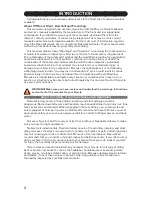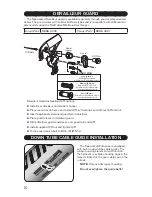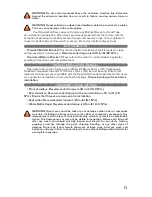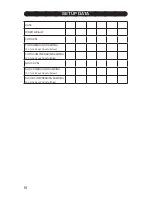
8
SHOCK SETUP
SETTING SAG
Enduro sag: 25 to 33% (14-18mm) of shock stroke
FOX RP23 BV and RP2:
Position the blue compression lever in the “Open” position to
the allow shock to sag more easily. After setting the pressure, push the rubber ring up to
the seal, sit on the bike gently, dismount, and measure sag.
DHX RC2:
Proper sag should be achieved with one turn of preload on the spring. More then
two turns of preload will require a higher spring rate or not enough sag will require a softer
spring rate. See spring rate chart for additional information or refer to the Fox shock manual.
NOTE:
See attached charts for starting air pressures or coil spring weights, or refer to the
Sag-O-Tron decal on the side of the seat tube and link to dial in the sag. The charts and Sag-O-Tron
are only a starting point, actual sag needs to be checked and adjusted on the bike, while riding,
and at regular intervals. Please refer to your shock owner’s manual for additional setup information.
SETTING COMPRESSION
Refer to the following air charts for the suggested amount of clicks or rotations based on
terrain. All suggested settings count the clicks counter-clockwise from the firmest setting.
RP23 BV:
Custom-designed for Specialized, the RP23 BV offers a climbing mode (lever
points toward air valve) and three “Open” modes of low-speed compression damping
(lever points away from air valve) to dial in the shock efficiency and ride characteristics.
Because suspension designs and riding skills vary, optimal settings can vary from
bike to bike and rider to rider. To determine which compression setting is better for your
condition and situation, pedal the bicycle and monitor the shock movement. Switch
between dial positions and select the one that reduces suspension movement most
effectively while providing the desired amount of bump absorption.
Open mode (Lever pointing away from air valve):
1.
Light: Very little compression damping for the least amount of support, with the most supple
and sensitive ride possible.
2.
Medium: Offers a balance of a bit more compression damping support without losing too
much small bump compliance.
3.
Firm: Highest degree of compression damping for the greatest amount of support, with the
least amount of small bump compliance.
RP2:
Two compression settings dial in the shock efficiency and ride characteristics.
1.
ProPedal On - provides slow speed compression to improve shock efficiency while still
allowing the shock to absorb medium and large size hits. This setting is great for all-
round riding providing an efficient pedaling platform while still absorbing trail features.
2.
ProPedal Off - very little compression damping for the most supple and sensitive ride possible.
SETTING REBOUND
RP23 BV and RP2:
Set rebound damping adjuster to rider preference. Refer to the air
charts for suggest click ranges according to rider weight. Typically a slower rebound for
slow speed, bigger hits to eliminate kickback, or faster rebound for higher speeds and
smaller hits, so the suspension does not pack up and has time to rebound between bumps.
DHX RC2:
Rebound damping controls the rate at which the shock returns after it has
been compressed. Clockwise for slower rebound (slow speed, bigger hits). Counter-
clockwise for faster rebound (higher speeds, small bumps, more traction).
SETTING THE IFP (Boost Valve)
DHX RC2:
The IFP (Internal Floating Piston) sets up the overall rate of compression
damping (Pressure range - 125 to 200 PSI). Higher pressure provides a more progressive
shock rate for more bottom-out control. Lower pressure provides a more linear shock rate
for less bottom-out control.





































